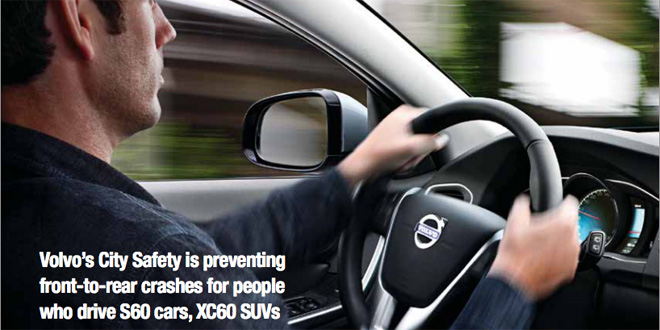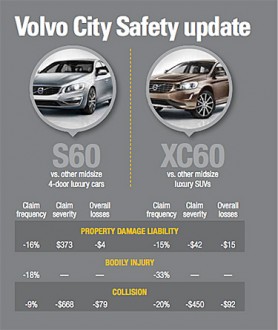One advanced technology continues to be a standout at preventing crashes. Forward collision avoidance systems with autonomous braking that can stop drivers from rear-ending another vehicle or slow them down enough to lessen the impact are making a measurable difference in insurance claims. Last year, the Highway Loss Data Institute (HLDI) reported promising results for Acura, Mercedes and Volvo models. Now there is fresh evidence that City Safety, Volvo’s low-speed collision avoidance system, is helping S60 and XC60 owners avert fenderbenders and minor injuries on congested roads.
“Consistent with prior results, this study shows that forward collision avoidance systems are working. That is good news because an increasing number of vehicles have these features,” says Matthew Moore, HLDI vice president and director of the study. “These features are preventing common, everyday crashes caused by inattentive drivers or drivers who don’t react quickly enough to emergency situations.”
HLDI in 2011 was first to quantify City Safety’s real-world benefits for XC60s with the feature in the U.S. (see Status Report, July 19, 2011, at iihs.org). The new analysis updates estimated benefits for XC60 midsize luxury SUVs and offers an initial look at insurance loss data for S60 midsize luxury cars.
In the report, claims under property damage liability coverage, the insurance that pays for damage to vehicles struck by an at-fault driver, were filed 16 percent less often for S60s than other midsize luxury cars. For the XC60, property damage liability claims were filed 15 percent less often than for other midsize luxury SUVs.
Last summer HLDI reported benefits for forward collision avoidance systems that work at higher speeds than City Safety to prevent or mitigate more serious crashes. Analysts also found benefits for adaptive headlights offered by Acura, Mazda, Mercedes and Volvo but no benefits so far for lane departure warning (see Status Report, July 3, 2012). Other features HLDI is gathering data on include blind spot detection, park assist and backup cameras.
About City Safety and HlDI’s analysis
City Safety uses a light detection and ranging sensor built into the windshield to detect a stopped or slower-moving vehicle ahead. If a crash is imminent, the system first precharges the brakes and if the driver doesn’t react, it independently and forcefully applies the brakes at the last instant before impact. Unlike some other forward collision avoidance systems, City Safety doesn’t alert the driver beforehand. It operates at speeds up to 19 mph.
City Safety has gained traction with Volvo owners. A 2012 Insurance Institute for Highway Safety survey of people who own 2010-12 models with the technology found that 86 percent would want it on their next vehicle (see Status Report, Dec. 20, 2012).
Because City Safety has been standard on XC60s since the 2010 model year, HLDI has sizeable data on the SUVs’ claims experience. Volvo added the feature to S60s starting with 2011s, so HLDI doesn’t have as much data on the cars. The new analysis reflects preliminary findings for the S60. There aren’t enough data to evaluate the effects on claims for other Volvos with the feature.
Analysts compared claims data for S60s and XC60s with other 2011-12 midsize luxury cars and 2009-12 midsize luxury SUVs. HLDI also compared the results with Volvo models that don’t have standard City Safety. The analysis controlled for a variety of geographic and demographic factors that can affect claims. Geographic
The analysis shows that drivers are far less likely to be in a crash in a Volvo with City Safety than a
car or SUV without the crash avoidance system.Volvo’s City Safety is preventing front-to-rear crashes for people who drive S60 cars, XC60 SUVsApril 25, 2013 |
factors include garaging state and vehicle density (number of registered vehicles per square mile). Demographic factors take into account the primary driver’s age, gender, marital status and risk. Other factors include calendar year and policy deductible.
HLDI looked at how often claims are filed, known as claim frequency, and claim costs, known as claim severity. Analysts examined frequency and payouts under property damage liability, bodily injury liability and collision coverage. Bodily injury liability pays for injuries to people in the crash other than the insured at-fault driver. Collision coverage pays for damage to the at-fault driver’s vehicle.
The 15 percent estimated reduction in the XC60’s claim frequency under property damage liability coverage is smaller than HLDI reported in its earlier analysis. In that report, HLDI found a 27 percent reduction in claim frequency compared with all other midsize luxury SUVs combined (see Status Report, July 19, 2011). A similar study by Swedish insurer Volvia/If and Volvo published in 2012 found a comparable 23 percent reduction in frontto-rear crashes for XC60s with City Safety in Sweden compared with other Volvo models without the feature.
“Although the estimated benefits in the current analysis aren’t as large as our first study indicated, the data still show that you are far less likely to be in a crash in a Volvo with City Safety than in a vehicle without it,” Moore says. “In addition, the effect appears robust, as the S60 shows a similar reduction in property damage liability claims.”
The average loss per claim under property damage liability for S60s was 13 percent higher than the average for other cars in its class. Because City Safety prevents minor crashes at low speeds, S60 owners filed fewer low-cost and midrange claims under $7,000 but had slightly more claims of at least $7,000 than other midsize luxury cars.
Costs under this coverage for XC60s were 1 percent lower than the average for other SUVs in its class. This contrasts with the S60 results as well as HLDI’s prior finding of 10 percent higher payouts for the 2010 XC60. The unexpected shift may reflect the changing makeup of the control group as more vehicles get crash avoidance features and not a difference in the XC60’s performance over time.
Overall losses under property damage liability for S60s were 6 percent lower than losses for all other midsize luxury cars combined, at $68 per insured vehicle year compared with $72 per insured vehicle year for the control group. (An insured vehicle year is one vehicle insured for one year, two for six months each, etc.).For XC60s, overall losses under property damage liability were 16 percent lower than losses for all other midsize luxury SUVs combined, at $78 per insured vehicle year compared with $92 per insured vehicle year for the control group.
In the crashes that City Safety is designed to address, people in both the striking and struck vehicles can experience minor soft tissue injuries like whiplash and back sprains. Severe or fatal injuries aren’t common at these speeds. City Safety is reducing claim frequency under bodily injury liability. The S60 had 18 percent fewer claims and the XC60 had 33 percent fewer claims than the comparison vehicles.
Collision claims benefit
Another unexpected finding is that City Safety is having a big effect on collision losses. Claim frequency under collision coverage was 9 percent lower for the S60 and 20 percent lower for the XC60 than the average of other vehicles in their respective class.
Collision coverage includes many of the same crashes as property damage liability but also single-vehicle crashes that City Safety isn’t designed to address. Fewer collision claims could indicate that City
Safety also is preventing collisions with some nonvehicle objects.
Collision claim severity for the S60 was 13 percent lower and overall losses were 21 percent lower than other midsize luxury cars. The XC60’s collision claim severity was 10 percent lower and overall losses were 28 percent lower than other midsize luxury SUVs. For a copy of “Volvo City Safety loss experience — an update,” email publications@iihs.org.



